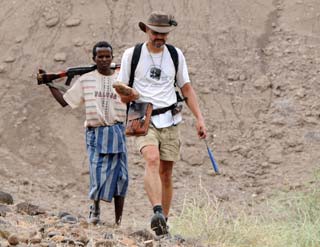Feature
Evolutionary Steps
New research shows the earliest humans moving from tropical forests to wooded grasslands.
| USF News

Wynn at the Dikika site, carrying a hippo fossil to show paleontologists. Mahammed, a local field assistant, accompanies Wynn. The team's guides are always armed wherever they go.
Photo courtesy of Jonathan Wynn
Since the first finds of human fossils, scientists have debated how the earliest humans lived and developed the attributes that have come to define modern man.
Now, new research published in the journal Nature by an international group of scientists, including USF geologist Jonathan G. Wynn, provides scientific evidence of the landscape that was the stage for human evolution six million years ago. Their findings indicate that early man came to learn to walk on two feet, find new food sources and develop advanced survival skills in the wooded grasslands of East Africa as they left their ancestral home in tropical forests.
Using chemical signatures recorded in ancient soils, the researchers show that some of man's most important evolutionary steps were taken on the savannahs of Ethiopia and Kenya during the time that spans the separation between man and chimps. By analyzing the sediments where fossils were found, the scientists were able to recreate the landscape and answer some of the persistent questions on how a changing environment helped drive human evolution.
"This is a whole new step in human evolution — even if it just means they (the early humans) were foraging for plants, they were learning new skills and new behaviors," Wynn says. "As environments continue to change, the lineage of humans that seem to survive are those that are adept at finding new foods or adapting to different conditions. It's the change in the environment that creates the new species."
Wynn played a central role in the announcement of one of the earliest and best-preserved hominin fossil ever found: "Selam," a juvenile Australopithecus afarensis female whose bones were discovered in Ethiopia in 2000.
Selam's remains are believed to be about 3.3 million years old, and her discovery opened the door for new understandings and new questions. Selam had well-developed feet and a lower body adapted for walking and human-like locomotion, but also the long arms that serve apes so well.
Working with scientists from the University of Utah, the Kenya Wildlife Service, James Cook University in Australia, Johns Hopkins University and the University of Arizona, the researchers, whose work was funded by the National Science Foundation and the Leakey Foundation, sought to document the environment in which Selam's and other early humans lived.
By establishing scientific evidence of their habitats, researchers can now move on to other significant questions of how these creatures continued to evolve and understand why some species of early humans did not survive.
To find out more and view a slideshow about Wynn's research, read the USF News article at usf.edu.